Publication or use of pictures, recipes, articles, or any other material form my Web site, on or off-line without written permission from the author is prohibited. If you would like to use my articles on your Web site or in your publication, contact me for details. Avoid infringing copyright law and its consequences: read the article 7 Online Copyright Myths by Judith Kallos
Read our
DISCLAIMER and
PRIVACY POLICY
before using
our site
-------------------
Linking Policy
Advertise with us
DISCLAIMER and
PRIVACY POLICY
before using
our site
-
Advertise with us
Copyright © 2003 - 2011 Anna Maria Volpi - All Rights reserved.
Anna Maria's Open Kitchen Site Map
site map
recipes
policies
about us
Some More Hot Topics You'd Like to See adv.



Printer
Friendly
Recipe
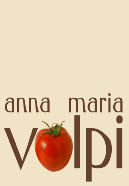



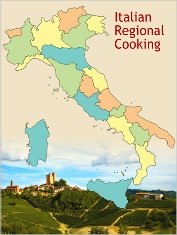

Anna Maria Suggests
Extra-
The Best Selection of Italian Extra-
Buy from the source Authentic Aged Traditional Balsamic Vinegar from Italy
Sicily, Apulia, Lazio, Liguria, and More...The Best Selection of Succulent Italian Olives Oil
Infused Extra-
Spice up your dishes with Infused Flavored Italian Extra-





Cherry Jam Tart
Crostata di Marmellata
How to Make a Traditional Cherry Jam Tart
Crostata di Marmellata
How to Make a Traditional Cherry Jam Tart
2 1/2 cups (350 gr) flour
2/3 cup (125 gr) sugar
6 oz (180 gr) butter, diced (lukewarm)
1 whole egg and 2 egg yolks
pinch of salt
grated rind of 1 lemon
6 oz (180 gr) butter, diced (lukewarm)
1 whole egg and 2 egg yolks
pinch of salt
grated rind of 1 lemon
1/2 lb (225 gr) cherry jam
Pour the flour onto a work surface, to form a mound shape with a hole in the center.
In the well, add the sugar, butter, eggs, egg yolks, pinch of salt, and grated lemon rind.
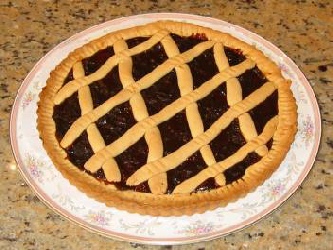
This is the most classic Roman home dessert. Traditionally it is made with visciole jam. Visciole are a kind of “morello”, a sour cherry, available in the countryside around Rome. Used in jams and preserves, these cherries have an unmistakable bittersweet taste. You can use any type of jam for this pie. Dark-colored jams, such as strawberry or cherry, look nice in contrast with the light dough.
When I became a mother, a young mother, I suddenly turned out to be very busy. My kid added a lot of work and action to my life. Nonna Romana, my husband’s aunt, was often coming to stay with us. She was an old frail lady by the infinite endurance, serenity, and patience. Her experience was priceless, as she was a precious and unlimited mine of information and tips.
I didn’t want to give up baking, an interest I loved so much and I wanted to bake for my baby something good and genuine. She thought me first how to make “morello” cherry jam, and then how to make this “Crostata”. It was for me the perfect cake: cheap, easy, never fails, makes your kid happy, and everyone likes it.
When I became a mother, a young mother, I suddenly turned out to be very busy. My kid added a lot of work and action to my life. Nonna Romana, my husband’s aunt, was often coming to stay with us. She was an old frail lady by the infinite endurance, serenity, and patience. Her experience was priceless, as she was a precious and unlimited mine of information and tips.
I didn’t want to give up baking, an interest I loved so much and I wanted to bake for my baby something good and genuine. She thought me first how to make “morello” cherry jam, and then how to make this “Crostata”. It was for me the perfect cake: cheap, easy, never fails, makes your kid happy, and everyone likes it.
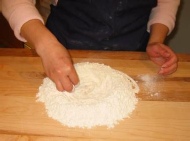
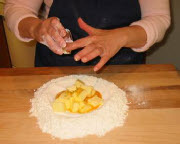
Work quickly with your hands, to form dough—avoid warming the dough too much. Sprinkle lightly the work surface with some flour to prevent the dough from sticking to the table.
Using a fork, mix the ingredients together with the flour.
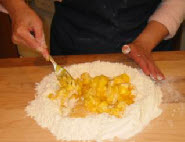
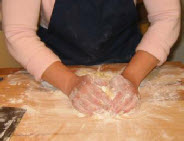
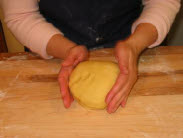
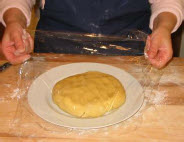
. . . cover with plastic wrap, and keep in the refrigerator for about 30 minutes to 1 hour.
When the dough is smooth, elastic, and consistent, form it into a ball ....
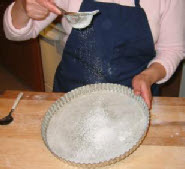
Preheat oven to 350 F (175 C). Remove the dough from the refrigerator. Butter a shallow tart pan—11 inches (28 cm) in diameter x 3/4-inch (2 cm) deep, with a removable bottom—and sprinkle with a small amount of flour.
Cut the dough in two parts, one quarter and three quarters large. Using a rolling pin on a floured surface, flatten the larger portion into the shape of a disk.
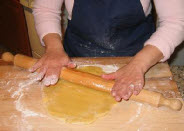
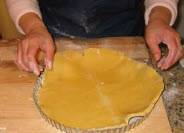
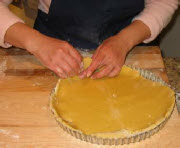
Place the disk flat in the pan . . .
. . . and with your fingers push it to uniformly cover the bottom of the pan.
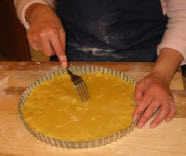
Prick the surface of the pastry evenly with a fork. This step will prevent the dough from puffing while baking.
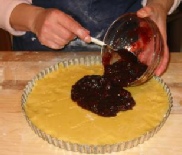
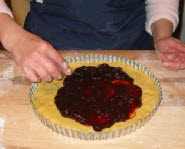
. . . and use a spoon to spread the jam around uniformly.
Place the jam in the center of the pan . . .
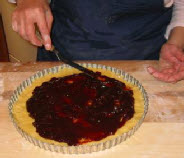
Roll small pieces of the remaining dough to form long little sticks approximately 3/8-inch (1 cm) thick.
Leave the perimeter of the tart free of jam, stopping about 1/2 inch (1 cm) before reaching the edge.
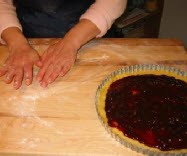
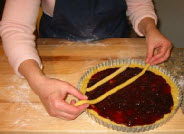
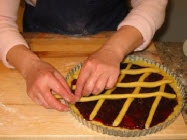
. . . creating diamond shapes by overlapping the pieces.
Place the sticks over the jam ....
Place the last stick around the perimeter.
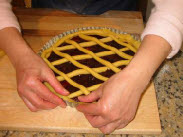
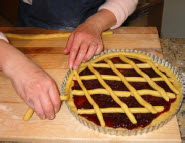
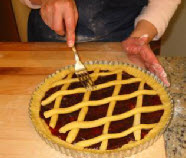
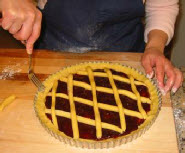
. . . then the overlapping sticks in the center.
Flatten the sticks of pastry with the prongs of a fork, first around the perimeter . . . .
Press around the edge to make it even.
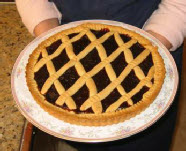
Bake the crostata for about 35 minutes, until the pastry is golden.
Desserts >> Crostata Cherry Jam Tart


My son enjoys crostata since he was one year old
INGREDIENTS
PREPARATION